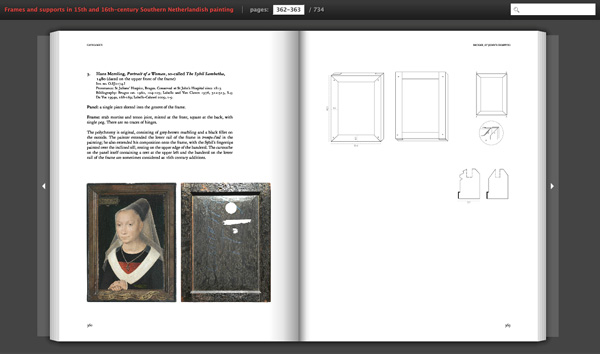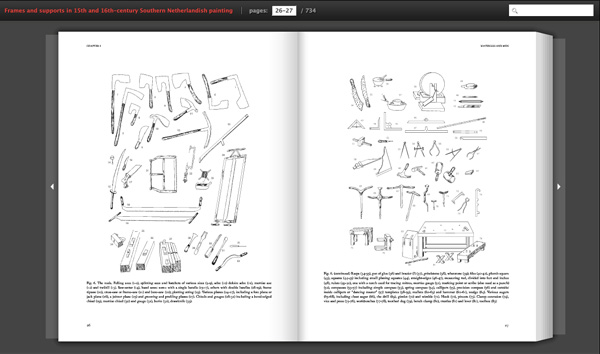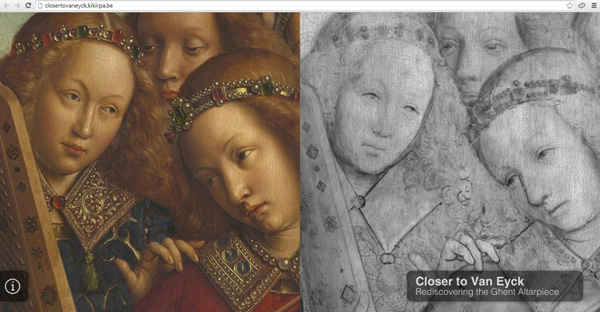
The Legend of St. Joseph (detail), possibly ca. 1490–1500, follower of Robert Campin. Hoogstraten, Church of St. Catherine. From Frames and Supports in 15th- and 16th-Century Southern Netherlandish Painting
Today marks the launch of a new in-depth study of selected panel paintings and their frames, Frames and Supports in 15th- and 16th-Century Southern Netherlandish Painting, supported by the Getty Foundation as part of the Panel Paintings Initiative.
This free e-book is published by KIK-IRPA, the Royal Institute for Cultural Heritage in Brussels, and written by scholar Hélène Verougstraete. Offering 700 images and 1500 diagrams, the book is an updated study based on the author’s 1989 doctoral thesis, which was prepared in French with black and white pictures. The new version has been fully translated into English and contains expanded research with crisp full-color illustrations and a searchable, zoomable interface. Oh, and did I mention there is a whole section devoted to the Ghent Altarpiece? Here, a few thoughts about what makes this new study so exciting.
Broken Engagements

Screenshot from Frames and Supports in 15th- and 16th-Century Southern Netherlandish Painting showing Hans Memling’s Portrait of a Woman with a diagram explaining the panel’s construction
Whoever knew that painting frames could be engaged? Well, as it happens, in early panel paintings (paintings on wooden planks), frames were often constructed as integral parts of the finished work of art. Over time, many of these engagements were broken off, so to speak, leaving only a relative small group of these works intact. A great example of an engaged frame can be seen in the screenshot above, which shows a delicately worked portrait by Hans Memling of 1480. Flip to the next virtual page, and you see how the work was originally constructed.
To Lathe or Not to Lathe

Diagrams of tools from Frames and Supports in 15th- and 16th-Century Southern Netherlandish Painting
Speaking as a conservator who specializes in wood, I often relate to a work of art by understanding the materials the artist used. I’m impressed by the fundamental historic insight this new e-book provides into the fabrication of panels and frames, delving deeply into the materials, techniques, and tools used by woodworkers.
And speaking of tools, contemporary woodworkers out there might be as surprised as I was to know that painting supports can be made on a lathe (a wood-turning instrument we think of more for use in carving cylindrical shapes, such as chair legs or baseball bats). Yes, it can be done! Not for a large painting, of course, but scroll down on “page” 294 to the small round painting from the workshop of Hans Memling and you will see. When you click on the images, not only will you be able to admire the delicate painting, but on the reverse you will see the coarse marks of the turning gouge. Moreover, the frame and panel are made of a single piece of wood!
A Closer Look

Detail of The Legend of St. Joseph, possibly ca. 1490–1500, follower of Robert Campin. Hoogstraten, Church of St. Catherine. From Frames and Supports in 15th- and 16th-Century Southern Netherlandish Painting
The experience of seeing old master paintings in person is unparalleled, but high-resolution digital images like those in this new publication offer their own unique value: the ability to zoom in and look at works of art in more detail than one could in a museum with the naked eye.
See, for example, the above detail of St. Joseph from a painting named The Legend of St. Joseph, by a follower of Robert Campin. The image shows a typical set of woodworking tools from around 1490, the very same tools woodworkers used to make panel paintings and frames. And when you click on the image, the entire painting appears in a new tab. Unfortunately, the image also show a huge split running down the middle of the panel. This is the precise reason for the Getty Foundation’s Panel Paintings Initiative, to ensure that a new generation of conservators have the skills to undertake the structural repair of damaged panels like this.
More Like This, Please

Homepage of the Closer to Van Eyck web application, also hosted by KIK-IRPA
If this publication isn’t enough, the Foundation has supported several other related digital projects through the Panel Paintings Initiative. Check out the Closer to Van Eyck web application, which reveals the Ghent Altarpiece in astonishing clarity and detail, or even more recently the Bosch Research Project that shares conservation documentation related to the works of the eccentric Netherlandish master Hieronymus Bosch. Together, these resources form a valuable set of reference materials for panel paintings conservators—and a fascinating way for anyone to dig deeper into artworks created by some of the most celebrated European artists of the past.




Comments on this post are now closed.
Trackbacks/Pingbacks